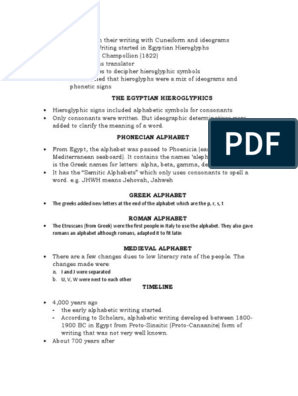0% found this document useful (0 votes)
47 views46 pagesAlphabets Module 2
The document outlines the evolution of early visual language systems into the alphabet, highlighting the transition from complex pictographs to a more simplified phonetic system. It discusses the origins of the Latin alphabet, its development through various cultures, and its widespread use today. Additionally, it covers the impact of the Greek and Aramaic alphabets, the introduction of new letters, and the transition from scrolls to codices in bookmaking.
Uploaded by
Giddel NaragCopyright
© © All Rights Reserved
We take content rights seriously. If you suspect this is your content, claim it here.
Available Formats
Download as PDF, TXT or read online on Scribd
0% found this document useful (0 votes)
47 views46 pagesAlphabets Module 2
The document outlines the evolution of early visual language systems into the alphabet, highlighting the transition from complex pictographs to a more simplified phonetic system. It discusses the origins of the Latin alphabet, its development through various cultures, and its widespread use today. Additionally, it covers the impact of the Greek and Aramaic alphabets, the introduction of new letters, and the transition from scrolls to codices in bookmaking.
Uploaded by
Giddel NaragCopyright
© © All Rights Reserved
We take content rights seriously. If you suspect this is your content, claim it here.
Available Formats
Download as PDF, TXT or read online on Scribd
/ 46





















































































